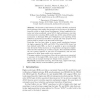108
click to vote
CORR
2004
Springer
15 years 24 days ago
2004
Springer
ACL2 was used to prove properties of two simplification procedures. The procedures differ in complexity but solve the same programming problem that arises in the context of a reso...
JAR
2007
15 years 26 days ago
2007
ACL2(r) is a modified version of the theorem prover ACL2 that adds support for the irrational numbers using non-standard analysis. It has been used to prove basic theorems of anal...
118
click to vote
JAR
2006
15 years 28 days ago
2006
We describe an approach to verifying bit-level pipelined machine models using a combination of deductive reasoning and decision procedures. While theorem proving systems such as AC...
118
click to vote
FMCAD
2006
Springer
15 years 4 months ago
2006
Springer
We describe a link between the ACL2 and HOL mechanical proof assistants that enables the strengths of each system to be deployed smoothly within a single formal development. Severa...
158
click to vote
CAV
1998
Springer
15 years 5 months ago
1998
Springer
As a pedagogical exercise in ACL2, we formalize and prove the correctness of a write invalidate cache scheme. In our formalization, an arbitrary number of processors, each with its...
CHARME
2003
Springer
15 years 6 months ago
2003
Springer
Abstract. As of version 2.7, the ACL2 theorem prover has been extended to automatically verify sets of polynomial inequalities that include nonlinear relationships. In this paper w...
135
click to vote
ACL2
2006
ACM
15 years 7 months ago
2006
ACM
One of ACL2’s most interesting features is that it is executable, so users can run the programs that they verify, and debug them during verification. In fact, the ACL2 implemen...
134
click to vote
ACL2
2006
ACM
15 years 7 months ago
2006
ACM
We have developed an extension of ACL2 that includes the implementation of hash-based association lists and function memoization; this makes some algorithms execute more quickly. ...
144
click to vote
ACL2
2006
ACM
15 years 7 months ago
2006
ACM
A verifying compiler is one that emits both object code and a proof of correspondence between object and source code.1 We report the use of ACL2 in building a verifying compiler f...
127
click to vote
ACL2
2006
ACM
15 years 7 months ago
2006
ACM
Several users have had problems using equivalence-based rewriting in ACL2 because the ACL2 rewriter caches its results. We describe this problem in some detail, together with a pa...






